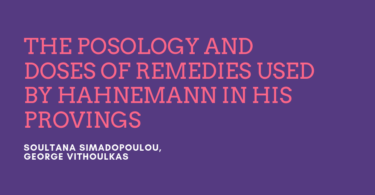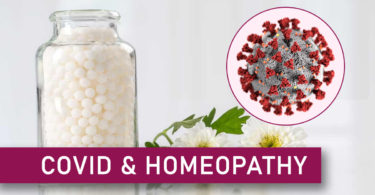
ABSTRACT: Pneumonia is an acute respiratory illness associated with recently developed radiological pulmonary shadowing, which may be segmental, lobar or multipolar. The context in which pneumonia develops is highly indicative of the likely organism(s) involved; therefore, pneumonias are usually classified as community or hospital acquired, or as occurring in immune compromised hosts. In this article an attempt is made to differentiate first grade and second grade remedies under the rubric Pneumonia from Murphy’s repertory.
INTRODUCTION: Pneumonia is an infection of the pulmonary parenchyma. Despite being the cause of significant morbidity and mortality, it is often misdiagnosed, mistreated and underestimated. Pneumonia historically was typically classified as community –acquired (CAP), hospital acquired (HAP), Or ventilator associated (VAP). A fourth category, health care associated pneumonia (HCAP), Was introduced recently.
Pneumonia results from the proliferation of microbial pathogens at the alveolar level and the host’s response to those pathogens. Microorganisms gain access to the lower respiratory tract in several ways. The most common is by aspiration from the oropharynx. Small –volume aspiration occurs frequently during sleep ( especially in the elderly) and in patients with decreased levels of consciousness. Rarely, pneumonia occurs via hematogenous spread (eg. From tricuspid endocarditis) or by contiguous extension from an infected pleural or mediastinal space. Traditionally, pneumonia used to be divided into two pathological categories namely lobar pneumonia and brochopneumonia. In lobar pneumonia, the consolidation is confluent and usually involves an entire lobe, while in bronchopneumonia, the infection is centred around the terminal bronchioles and extends into the surrounding alveoli causing patchy consolidation.
Classic pneumonia evolves through a series of pathological changes. the initial phase is one of edema, with the presence of a proteinaceous exudates and often of bacteria in the alveoli. This phase is rarely evident in clinical or autopsy specimens because of rapid transition to the red hepatization phase. The presence of erythrocytes in the cellular intra-alveolar exudate gives this second stage its name, but neutrophil influx is more important with regard to host defense. Bacteria are occasionally seen in pathological specimens collected during this phase. In the third phase, grey hepatization, no new erythrocytes are extravasating and those already present have been lysed and degraded. The neutrophil is the predominant cell, fibrin deposition is abundant, and the bacteria have disappeared. This phase corresponds with successful containment of the infection and improvement in gas exchange.
In the final phase, resolution, the macrophage reappears as the dominant cell type in the alveolar space, and the debris of neutrophils, bacteria, and fibrin has been cleared, as the inflammatory response.
Pneumonia is usually heralded by the onset of fever which may be associated with chills. Other less common systematic symptoms include nausea, vomiting, diarrohea, headache, myalgia, and arthralgia. Cough is usually present and it may or may not be associated with mucoid or purulent expectoration. occasionally, the sputum may be blood tinged. Breathlessness may vary depending on the extensiveness of the parenchymal involvement.
The rubric pneumonia in murphy’s repertory has 2 first grade remedies and 18 second grade remedies
Remedy Gradings : The new remedy gradings for the Medical repertory display the strongest remdies in the following manner:
CALC.,(4 Points,) bold-capitals and underlined
CALC., (3 Points), bold capitals
Calc., (2 points), bold-italics
Calc., (1 point), plain-small
First grade remedies – 4 marks
Antimonium tartaricum
Phosphorus
Second grade remedies – 3 marks
Aconitum
Arsenicum Album
Arsenicum Iodatum
Bryonia
Carbo Vegetabilis
Chelidonium
Ferrum Phosphoricum
Hepar Sulphuricum
Kali Carbonicum
Lobelia inflata
Lycopodium
Mercurius
Pulsatilla
Rhus Toxicodendron
Senega
Sepia
Sulphur
Veratrum VIride
ANTIMONIUM TARTARICUM
- Respiration – difficult, necessitating an upright position. Short, from retained expectoration. Paralysis of lungs.
- Cough – short coughs following each other in quick succession, excited by tickling and creeping in throat and larynx; dry in evening; with expectoration of tenaceous mucus generally somewhat salt; often only flat or sour in morning . with vomitting of food and sweat on forehead with suffocative attacks. Rattling , hollow.
- Whooping cough after eating or anger in children. nightly with expectoration of mucus. After paroxysms, dizziness, sweat on forehead. Yawning and great sleepiness.
PHOSPHORUS
- Respiration – difficult with anxiety in chest. Spasmodic tightness of chest. Nightly suffocative attacks. Cough hollow hacking excited by tickling or itching in chest. With rawness and hoarseness in chest. With sticking in throat. Spasmodic dry, straining cough with bursting headache. Dry in evening and night; in morning and by day.
- Expectoration of a tough whitish mucus apparently mixed with dust, or of a yellow pus-like or a rust colored, often cold mucus, of a sour, salty, or sweetish taste, or else of bright red, frothy blood. When whooping cough threatens an unfavourable course.
Second grade remedies – 3 marks
ACONITUM
- Chest – constant pressure in left chest. Violent congestion of blood in chest. Oppression of chest when moving fast or ascending in heart disease. Blood comes up on hawking. Sharp pain in the chest. Tingling in chest after coughing. Pressive weight and burning under sternum.
- Cough – with nervous excitability hoarse dry croupy cough, loud, labored breathing. Cough better lying on back. cough from walking in open air. Cough worse at night and after midnight.short, barking, ringing or whistling cough, worse every inspiration, at night. Loud, rough, croacking cough, on expiration. Croupy,dry, coarse, suffocating cough. Hemoptysis from mental excitement.
ARSENICUM ALBUM
- Pneumonia from taking cold. Pneumonia during a fatiguing journey . hydrothotrax. Pulmonary edema. Gangrene of lungs with green ichorous sputum.
- Expectoration scanty frothy. Expectoartion thick, yellow, green, bitter,salty. Very tenacious mucus in lungs. Bloody expectoration. Mucus streaked with blood. Tightness of chest during motion. Suffocative attacks in evening after lying down. Oppression of chest when ascending and whenin cold air. Shortness of, when walking or turning over in bed.
ARSENICUM IODATUM
- Catarrhal pneumonia with muco-purulent expectoration, dyspnoea, night sweats. Pneumonia that fails to clear up. Bronchopneumonia after influenza. Rales and crepitation. Pleuritis short of breath, air hunger. Feeble respiration. Expectoration , yellow-green, foul. Muco-purulent and occasionally stringy mucus.
BRYONIA ALBA
- Pneumonia with painful cough. Rusty. Tenacious sputum. Brick colored, blood-streaked sputum. Sputum like lumps of jelly. Tough mucus in trachea, loosened only with much hawking .yellowish mucus. Dry ,friction sound.
- Cough with feeling as if head and chest would fly into pieces. Very painful coughs must hold the chest. Cough with sharp pain in the sides of chest.
CARBO VEGETABILIS
- Asphyxiation .Breathing ,laborious, quick and short, worse walking. Wants to take a deep breath. Breath cold, must be fanned. destructive lung diseases. Cough with itching in larynx, spasmodic cough, bluish face, offensive expectoration.
- Occasional spells of long coughing attacks. Wheezing and rattling of mucus in the chest. expectoration is very thick, sticky, yellow and profuse. Hemorrhage from lungs. Neglected pneumonia roughness in larynx with deep rough voice.
CHELIDONIUM
- Hemoptysis. Copious, mucus, in morning . bronchial pneumonia. Bilious pneumonia. Blood streaked phlegm, or brownish –bloody sputum. Right sided pneumonia. Small lumps of mucus fly from mouth when coughing. In left lung soreness like a wound, by deep breathing, coughing and sneezing.
FERRUM PHOSPHORICUM
- First stage of all inflammatory affections. Pneumonia, the first stage. Hemoptysis of pure blood, in pneumonia, after concussion or fall. Pleurisy, sharp pain,right side, worse coughing and breathing.
HEPAR SULPH
- Pneumonia in suppurative stage with fever. Lobar pneumonia. Chronic pneumonia, with profuse purulent expectoration . breathing difficult worse lying on left side. Chest- constriction and tightness, oppression. Anxiety and heat in chest. Burning sharp, sore, pressing pains, worse motion.
KALI CARBONICUM
- Shortness of breath in morning.dyspnoea, as if no air could get into lungs. Labored breathing, after paroxysms of cough. Arrest of breath awakens at night. Leaning forwards relieves chest symptoms. Pneumonia, pneumonia after measles.
- Never well since pneumonia. Pleurisy. Pleuritis with violent palpitations. Hydrothorax. Expectoration must be swallowed, cheesy taste, copious, offensive, lumpy. Expectoration scanty and tenacious.
LOBELIA INFLATA
- Constrictive or oppressive fullness in chest. sensation of pressure or weight in chest, better by rapid walking. Hyperventilation. Short inhalations and long, deep exhalation. Panting, threatened with suffocation, fear of death.
- Dyspnoea from constriction of chest, worse any exertion. Dyspnoea from short exposure to cold. Rattling in chest but no expectoration.
LYCOPODIUM
- Dull aching all over lungs.Craves air but is chilled by it. Shortness of breath. Difficult breathing due to hydrothorax. Dyspnoea worse lying on back,during sleep. Short, rattling breathing, worse on lying back.
- Neglected or unresolved pneumonia with great dyspnoea. Expectorations gray, thick, bloody, purulent, salty. Expectoration greenish –yellow, lumpy or foul expectoration.
MERCURIUS
- Dyspnoea,when coughing or sneezing.Desire to take deep breath from anxious oppression.shortness of breath on going upstairs or walking quickly.Lungs as if heavy in asthenic pneumonia .pneumonia with cough and dyspnoea.Pneumonia with jaundice. Suppuration of lungs after hemorrhages, or after pneumonia.
PULSATILLA
- Craves open fresh air, must open the window. Shortness of breath, anxiety and palpitations worse lying on left side. Cough must sit up in bed to get relief. Bland yellow greenish expectoration. Large quantities of yellow, thick, lumpy mucus, worse mornings.
- Bronchopneumonia in chlorotic or anemic women. Acute suppuration of lungs. Pneumonia from hepatic troubles or during measles.
RHUS TOXICODENDRON
- Oppressed breathing, as if breath would stop at the pit of stomach. Anxious breathing as if not able to draw a long breath. Hemoptysis bright red blood.
- Sudden hypostasis or edema of lungs. Pale, clotted brown blood. Rust colored sputum. Expectoration, acrid pus.Gray-green cold mucus of putrid smell. Pneumonia with typhoid symptoms, often after reabsorption of pus.
SENEGA
- Bronchial catarrh with sore chest walls, much mucus, sensation of oppression and weight of chest bursting pain in back on coughing. Cough often ends in sneeze. Rattling in chest. Exudations in pleura. Pleuro-pneumonia. Difficult raising of tough, profuse mucus in the aged.
SEPIA
- Dyspnea, worst after sleep, better rapid motion. Neglected pneumonia. Pleuritis. Copious very offensive expectoration, after lying down. Yellow,green or grey pus. Expectoration milk-white, tenacious mucus, generally of salty taste, in morning.
SULPHUR
- Difficult respiration, wants windows open, nightly suffocative air hunger, dyspnoea in middle of night, relieved by sitting, irregular breathing.
- Cough violent in two or three incomplete bouts, tickling as from down in larynx. Greenish, sweetish purulent expectoration. Violent cough with headache worse lying on back. As of rivet through upper third of left lung. Neglected pneumonia.
VERATRUM VIRIDE
- Dyspnea. Difficult breathing. Slow and heavy breathing, as of a load on chest. Congestion of lungs. Pneumonia with faint feeling in stomach and violent congestion. Croup. Violent cough from very start.
CONCLUSION
The Repertory helps us to find out the required symptoms, together with the medicine or or a group of medicines having different grades. It is a connecting link between the materia medica and disease. This article helps in differentiating first grade and second grade remedies under the rubric pneumonia which is very useful in clinical practice.
REFERENCES
- A Mandell.Wunderink R.Harrison’s principles of of internal medicine 20th ed. New york (etc):McGraw-Hill Education;2018.
- Prasad K, Behera D.API Textbook of medicine.11th ed. Mumbai. The associations of physicians of india; 2019
- Reid P. Innes J.Davidson’s principles and practice of medicine.22nd ed.Elsevier.2018.
- Boericke W. Boericke’s new manual of Homoeopathic materia medica with repertory 3rd ed. New delhi;B jain publishers;2017
- Murphy D. Lotus materia medica.3rd ed.Noida UP:B jain publishers Pvt Ltd;2017
- Boger C. Boenninghausen’s characteristics and repertory with word index. Noida UP. B jain pub.pvt ltd; 2019.
- Tiwari S. Essentials of Repertorization.5thed.NoidaUP;BJain publishers;2016.
- Murphy R. Homoeopathic medical repertory.3rd ed. New Delhi:B Jain;2019
About Author:
Dr Bharath Raj C K
Department of case taking and Repertory
Under the guidance of Dr Anusuya M Akareddy
Government Homoeopathic Medical College and Hospital
Bengaluru




